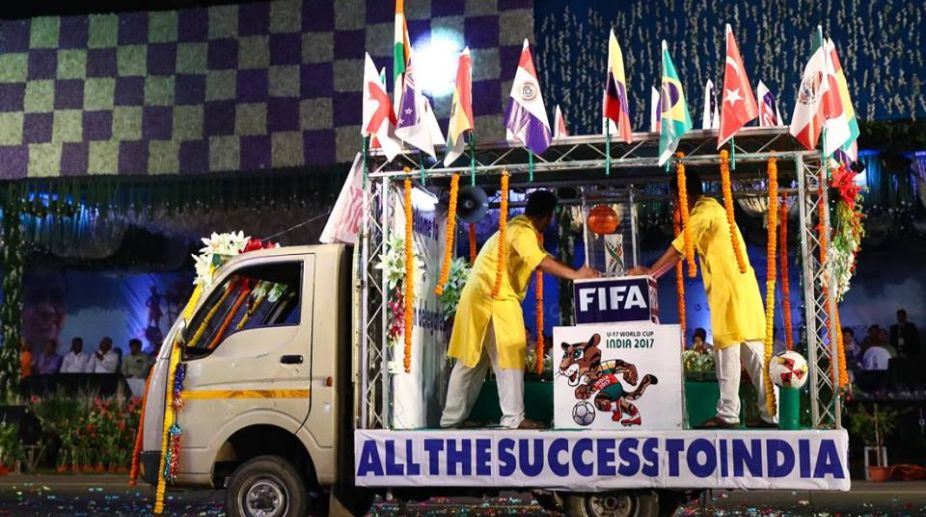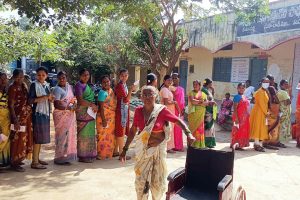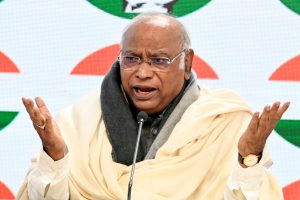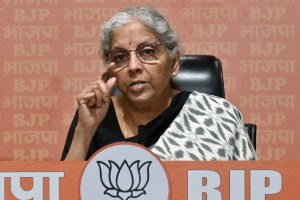It is carnival time in Kolkata. Some days ago, thousands watched the grand finale to West Bengal’s biggest festival of Durga puja with a spectacular road show on historic Red Road. The glittering parade overwhelmed thousands who had assembled to have a glimpse of the idols trundling down the road and heading for immersion to the Ganges.
As the curtain was drawn on the Durga puja carnival, it made way for another – the U-17 World Cup Football – that began in Kolkata on October 8. The baton changed from the puja carnival to the football carnival. In fact, the four-hour long procession of elegant community Durga Pujas had football as a theme woven into it by many puja organizers.
It looked like a perfect blend – one complimenting the other in a seamless transition from Puja carnival to football carnival. The principal architect behind West Bengal’s second edition of Durga Puja carnival – the West Bengal chief minister had a gentle smile pasted on her face as she watched the proceedings. And why not? It was her moment of triumph over her adversaries.
With a sizeable audience of foreign visitors in the VIP enclosures, including several U-17 World cup team players, and consular corps – the West Bengal chief minister was commanding global attention as well as addressing the domestic constituency. For discerning minds, the puja carnival was not a mere event of merry making but carried deep political messages.
Both the mega events had larger impacts as they turned out to be ideal weapons for Didi to fight her political battles. Both depicted the government’s success stories with happy endings. To put things into perspective, one would rewind to the days preceding the Durga puja when the West Bengal government’s ban on immersion timings had triggered a raging controversy.
The chief minister was accused of indulging in minority appeasement and brazen vote bank politics. The government of the day was trying to mix religion with politics, critics cried. The judicial proclamation, setting aside the government order restricting the immersion timings had appeared to be a setback to the government.
Also, one would recall the Hon’ble Calcutta High Court’s observations a day before its final judgment in which it had wondered: “Why can’t two communities celebrate together? When you (state government) are firm there is communal harmony in the state, why are you creating communal distinction between the two? Let them live in harmony. Do not create a line between them. Let them live together,” the court had observed in what appeared to be an indictment of the state government.
But Mamata Banerjee had her own way of damage control. At the end of the Red Road puja carnival, even her bitter critic would have little doubt about the ardent patronage she gave to the Durga puja festival. If the saffron brigade had thought of capitalising on the minority appeasement issue, here was the leader standing larger than life on Red Road, distinctly emerging as one of the biggest stake holders of this Hindu festivity.
The voices of criticism were muted. If the carnival was a big picture canvas, the more subtle but orchestrated flashing images were those of carnival participants like Firhad Hakim or Arup Biswas – both ministers in Mamata Banerjee’s cabinet mingling with each other.
As the media focussed on them, there seemed to a carefully woven narrative of Hindu-Muslim amity and coexistence. Hakim was just back from Mecca after the holy pilgrimage and here he was as a known, veteran patron of the Durga puja.
The Red Road show over, the spotlight shifted to the Swami Vivekananda Yuvabharati Krirangan in Salt Lake. Like Durga Puja, football is yet another expression of Bengal’s passion, enthusiasm and exuberance. Banerjee did not let this opportunity go, either. Her government had worked to a strategy to showcase this mega football event and it would reap rich dividends for her.
The Salt Lake stadium has undergone a magnificent transformation over the past year with about Rs 200 crore pumped into its overhaul and upgrade into a World Cup class stadium and sporting venue. A large component of it had come from FIFA.
The state government too had generously contributed to the Bidhannagar (Salt Lake) municipality to create physical infrastructure of world standards. When the host city logo of Biswa Bangla was launched in the last week of August along with the FIFA U-17 Football World Cup, the chief minister captured the spirit saying: “It is going to be the biggest football bonanza Kolkata has ever seen. We are very happy that a global event of this scale has come to Kolkata.”
Kolkata is home to football hungry fans. Built by the Communists in the 1980s to accommodate a record 100,000 fans, the stadium was lying in neglect and decay. It was a stupendous task to upgrade the stadium in a short span of a year.
But much of it had been achieved as Javier Ceppi – the Chilean Tournament director for the U-17 World Cup – went on record to say: “It is a world class facility at this point of time.”
The stadium was officially handed over to FIFA on September 10. By then the state sports department had incorporated sweeping changes to its facilities. New bucket seats, natural grass turf, air conditioned changing rooms for players, presidential lounge, media zone, landscaped gardens, new FIFA standard practice grounds with flood lights – were among some of the new inclusions. A special type of American grass was brought and planted in the main ground. Thousands of illegal shanties were dismantled and the dwellers evicted from parks, gardens and pavements in silent but determined clean up drives.
The municipal body in Salt Lake displayed the courage to resort to this unpopular step and had largely been successful in containing public outbursts. Now, Kolkata will get to see the future stars of the football world.
Also, stars of yesteryears like Diego Maradona and a host of others who are expected to arrive soon and give a boost to Kolkata’s already surcharged football spirits. In a city known for processions, chaos and commotion – the football carnival is likely to create a resonance that may have long term benefits for this regime.
(The writer is Director, Statesman Print Journalism School)










